Co-investigators Paul V. Benson, M.D., associate professor in the Department of Pathology, and Threnesan Naidoo, M.B.Ch.B., professor and head of Division of Forensic Pathology at Walter Sisulu University and president of the College of Forensic Pathologists of South Africa, are using forensic pathology to research tuberculosis (TB) in a partnership between UAB and the Africa Health Research Institute (AHRI) in Durban, South Africa.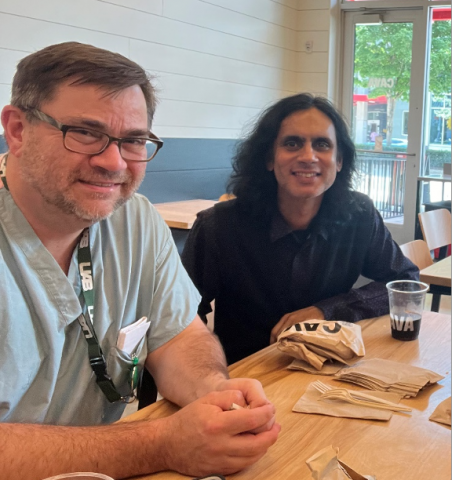 Paul V. Benson, M.D., and Threnesan Naidoo, M.B.Ch.B.
Paul V. Benson, M.D., and Threnesan Naidoo, M.B.Ch.B.
Benson and Adrie J.C. Steyn, Ph.D., professor in the Department of Microbiology, are part of a Mary Heersink Institute for Global Health (MHIGH) pilot project led by Steyn, conducting an intercontinental TB research collaboration.
MHIGH launched its pilot project grant to promote cooperation and provide resources to UAB researchers and global collaborators to address urgent global health issues.
“During the pandemic, Steyn said to me, ‘When COVID-19 is over, you should come to South Africa and visit our lab there,’ and I said I would love to. I never imagined it would actually happen until we applied for the Mary Heersink Institute for Global Health pilot grant, and we got it,” said Benson. “Next thing I knew, I was going to Durban to meet the lab there.”
Following Benson’s visit to AHRI in December 2022, they felt it essential for Naidoo to visit UAB in 2023. During this visit, Naidoo toured the UAB Department of Pathology, spent time in Steyn’s microbiology research lab, visited the Jefferson County coroner/medical examiner’s office, presented a lecture on “Death investigation and forensic pathology in South Africa,” and conducted an interactive teaching slide seminar discussing South African cases for pathology residents.
Naidoo and Benson sat down to discuss their visits and intercontinental partnership.
Q: What sparked your interest and passion in this type of research?
Naidoo: First and foremost, TB is endemic in South Africa. It's a major health problem for South Africans, with significant morbidity and mortality. I am a TB survivor myself who has struggled with recurrent TB for many years, including the fallout of harsh, prolonged, and outdated treatment regimens. So, this particular research is both a personal crusade as well as a professional undertaking.
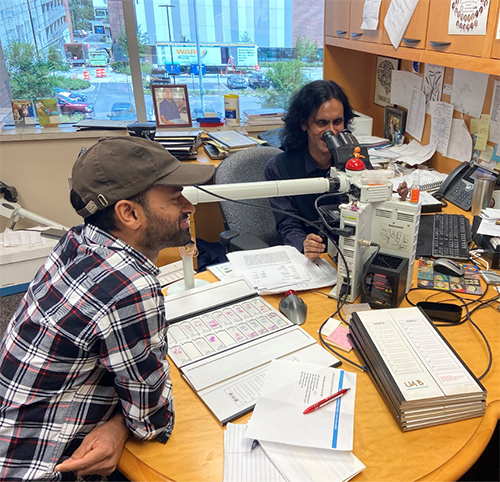 Naidoo and Sajid Nadeem, Ph.D., reviewing TB casesSecondly, forensic pathologists, like Dr. Benson and myself, are usually involved in diagnostic medico-legal service work exclusively. Unlike our clinical counterparts, who participate directly in treating patients, autopsy practitioners are not positioned at the forefront of the clinical interface. As a result, we have to constantly find more innovative ways to make a more direct contribution to public health outcomes. I think this propelled me to look at how I can move from the diagnostic platform in forensic pathology into the research domain and combine these passions by turning my service work into teaching, training, and research material. Although this journey was very much an evolution over time, it also felt like a natural transition to progressively integrate my forensic service work with medical education and scientific research. As autopsy researchers, Dr. Benson and I now have a unique opportunity to make a more direct contribution to public health, transforming the prevailing mindset that has seemingly forgotten the value of autopsy-based research.
Naidoo and Sajid Nadeem, Ph.D., reviewing TB casesSecondly, forensic pathologists, like Dr. Benson and myself, are usually involved in diagnostic medico-legal service work exclusively. Unlike our clinical counterparts, who participate directly in treating patients, autopsy practitioners are not positioned at the forefront of the clinical interface. As a result, we have to constantly find more innovative ways to make a more direct contribution to public health outcomes. I think this propelled me to look at how I can move from the diagnostic platform in forensic pathology into the research domain and combine these passions by turning my service work into teaching, training, and research material. Although this journey was very much an evolution over time, it also felt like a natural transition to progressively integrate my forensic service work with medical education and scientific research. As autopsy researchers, Dr. Benson and I now have a unique opportunity to make a more direct contribution to public health, transforming the prevailing mindset that has seemingly forgotten the value of autopsy-based research.
Historically, almost everything we have learned about medicine and pathology has originated from some form of autopsy work. However, autopsy rates have declined over the years, and other research modalities have enjoyed much more attention. We want to bring back the autopsy as a mainstream research tool and further modernize it with all the sophisticated technologies that are now available. Dr. Benson has recently done quite a bit of research on COVID-19, but autopsies can be used to study any number of conditions. Currently, our work is focused on TB. In doing so, we've succeeded in debunking the misconception that forensic postmortem samples are not accessible or suitable for high-level scientific research.
Benson: Research wasn't really one of the things that brought me to UAB. I was a full-time medical examiner in Memphis, doing over 300 autopsies a year and very little research. I came to UAB in 2019 to teach and do service work on the UAB hospital autopsy service. COVID-19 changed all of that. COVID-19 caused a resurgence of the use of autopsy material for research. Since then, I have been pretty well-positioned to work with a lot of UAB and outside collaborators to leverage our autopsy material for research. We have a lot of archived diagnostic material from autopsy studies performed at UAB, and the methods and technologies we developed during the pandemic directly translate into using autopsy material for TB research. We've had almost a dozen publications from autopsy material in the last two or three years with multiple collaborators at UAB. So, my interest in research has been born at UAB during the COVID-19 pandemic.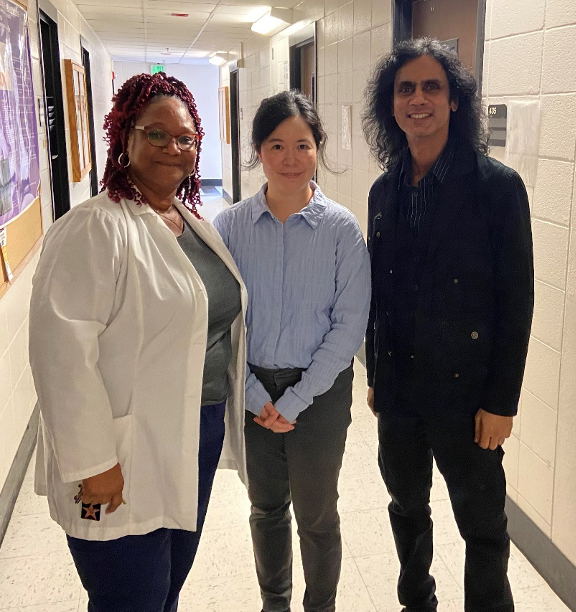 Patty Williams, M.D., Dezhi Wang, M.D., and Naidoo, at core lab tissue biorepository
Patty Williams, M.D., Dezhi Wang, M.D., and Naidoo, at core lab tissue biorepository
One of the major silver linings of being part of COVID-19 research at UAB was meeting Dr. Steyn and Dr. Naidoo and collaborating with them on TB research. I'm interested in seeing what kind of difference we can make. We've already been productive in showing the 3D structure of the TB granuloma, which had not been described before. We are working our way toward showing transcriptomics in TB cases in people who died from something that wasn't TB and who may have latent TB. We are also investigating cases that have an autopsy but also had several biopsies done over the course of life. These cases allow researchers to examine how the host’s response to TB changes over time.
I also have a strong feeling that latent TB in the U.S. is more of a burden than we know based on our current diagnostic modalities, such as the AFB or Ziehl-Neelsen stain. This unique research team can help better characterize all of these things.
Q: Was there anything that you experienced during your visit to UAB that you are excited to apply to your work in South Africa?
Naidoo: I felt very privileged because Dr. Benson arranged a perfect itinerary for my interests and medium to long-term teaching and research goals in South Africa. The itinerary included several visits to medical education, the UAB Department of Pathology, and the Jefferson County coroner/medical examiner’s office. I'm closely involved with medical education and assessment in forensic pathology and anatomical pathology in South Africa at the undergraduate and postgraduate levels. It was interesting to look at what we have in common and establish some links so that we can support and strengthen our programs by sharing our resources and experiences. We visited the UAB Department of Pathology training and service component to meet the laboratory personnel and residents. Again, comparing notes and seeing what we have in common, the differences in service delivery and postgraduate training, and the forensic service platform was incredibly enlightening.
Going to the Jefferson County coroner/medical examiner’s office and the forensic toxicology laboratory at UAB was also very informative. This was my first time observing forensic work outside my country, and I found it very insightful. I had only read about the coroner and medical examiner systems in textbooks. Witnessing firsthand the daily operational aspects was truly an amazing, eye-opening experience for me. In particular, it was interesting to see how the support in place in the U.S. can improve and optimize forensic service delivery. The similarities in autopsy practice were very encouraging for me because I realized that wherever you go and whatever resources you have, it always comes down to following simple, basic scientific principles and how you apply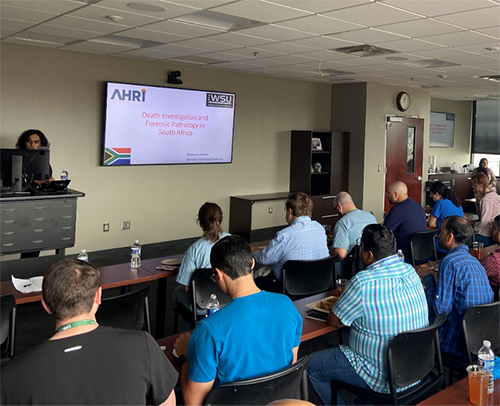 Naidoo presenting “Death Investigation and Forensic Pathology in South Africa” them in different contexts. In terms of actual autopsy practice and procedures, it's exactly the same in both our countries, but the added value of some of the resources and systems available in the U.S. gave me ideas that I will certainly take back home. I was also able to compare our legal systems and how death investigations are done in South Africa versus the U.S. That was actually an important part of my presentation, “Death Investigation and Forensic Pathology in South Africa.”
Naidoo presenting “Death Investigation and Forensic Pathology in South Africa” them in different contexts. In terms of actual autopsy practice and procedures, it's exactly the same in both our countries, but the added value of some of the resources and systems available in the U.S. gave me ideas that I will certainly take back home. I was also able to compare our legal systems and how death investigations are done in South Africa versus the U.S. That was actually an important part of my presentation, “Death Investigation and Forensic Pathology in South Africa.”
Another major highlight of my visit was meeting the biorepository experts at UAB. I am trying to establish a tissue biorepository and a virtual biobank of whole slide images at AHRI. The intention of this endeavor is to provide a global resource that is equally accessible to local and international scientific communities for collaborative research. These meetings at UAB were especially helpful because they provided me with information, insights, and advice to support my efforts in South Africa.
Q: Was there anything that you experienced during your visit to South Africa that you were excited to apply to your work at UAB?
Benson: When I was there in December of 2022, I had never been out of the U.S. alone and never that far away. One of the largest things I noticed was my preconception that South Africa and the people I met there would be radically different from where I live and the people I interact with at UAB on a daily basis. I was struck by how similar the work and people are at UAB and South Africa. I felt quite at home talking to everybody when I finally got to sit down and chat with them about work, forensics, autopsy, and pathology. I quickly forgot that I was 8,500 miles from home. It felt like talking to old friends I had never met.
I was given a tour of the Inkosi Albert Luthuli Central Hospital, including its pathology lab and autopsy area. They have a very nice autopsy pathology and teaching facility. I would love to work in a facility as nice as theirs. The rest of the pathology lab is like walking around our UAB pathology lab. They have the same equipment and people doing the same things. It's interesting to see their operations, talk to them, and learn how we can work together. That is what drives us forward, I think.
Q: What effects have you seen from your research and the UAB-AHRI project, and what do you hope to accomplish in the long-term?
Naidoo: We have several long-term goals with our work and collaboration. I've mentioned that we are keen to revive autopsies as modern-day research tools and modernize the investigations performed on postmortem samples. Apart from that, coming predominantly from service into research, I've always been perplexed at the level of competition that prevails in research. Healthy competition is admittedly important for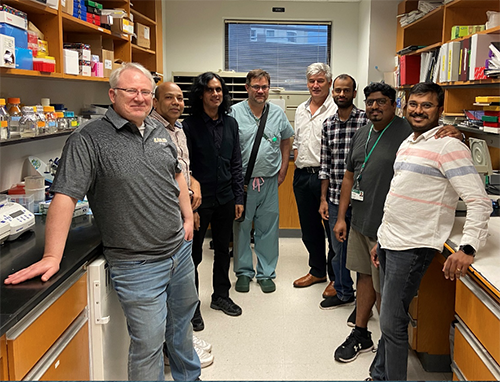 Naidoo's last day visiting Steyn's Lab progress, but it should never be to the overall detriment of advancing research and public health. I think that's one of the driving forces behind the way we are trying to work. We want to be complimentary and collaborative in all aspects. We don't profess to know all the answers or to be able to unlock all the answers to all health problems. However, if we can foster an ethos of collaboration on a global scale and lead by example through the UAB-AHRI partnership, then perhaps we can incite a true paradigm shift in TB research. I think when people speak about changing a paradigm, they sometimes use the term flippantly. When you want to make a true difference, there must be a meaningful change in the methodology and value system. This transformation must occur not only at a scientific but at a human level as well. If we can work together and combine our strengths, then we are bound to have a better outcome.
Naidoo's last day visiting Steyn's Lab progress, but it should never be to the overall detriment of advancing research and public health. I think that's one of the driving forces behind the way we are trying to work. We want to be complimentary and collaborative in all aspects. We don't profess to know all the answers or to be able to unlock all the answers to all health problems. However, if we can foster an ethos of collaboration on a global scale and lead by example through the UAB-AHRI partnership, then perhaps we can incite a true paradigm shift in TB research. I think when people speak about changing a paradigm, they sometimes use the term flippantly. When you want to make a true difference, there must be a meaningful change in the methodology and value system. This transformation must occur not only at a scientific but at a human level as well. If we can work together and combine our strengths, then we are bound to have a better outcome.
For example, our TB research involves basic science approaches, pathology approaches, and clinical science approaches. These groups don't necessarily engage with each other, but if we bring them all together in one room, you will find that they speak the same language and share a common goal. Perhaps some translation is needed between the basic and clinical sciences, but that's where the pathologists come in. We translate the basic science language for the clinical practitioners and vice versa. I am a proponent of multi-, inter-, and trans-disciplinary research. Therefore, I strongly advocate for collaboration and facilitating a more holistic response to research by bridging the longstanding gaps between the basic sciences, health sciences, and social sciences. I’m obviously somewhat biased, but I believe that pathologists play a pivotal role in establishing and promoting this kind of research model.
Dr. Benson, Dr. Steyn, and I are doing precisely that by strengthening the alliance between UAB and AHRI and displaying it to the greater scientific community. We have been calling for a unified global research community for TB that welcomes the integration of animal models and human models, thereby uniting the ongoing efforts of basic scientists and clinical scientists.
Benson: Reviving autopsy material for research use is a major part of it, but I was thinking about the collaboration efforts of our research. Could I do that with another university in the U.S.? Do we need to be working with AHRI in South Africa to be able to do this? The answer, I think, is yes. The people, the facilities, the materials, and the attitudes at both AHRI and UAB are very complementary and naturally fit for this collaboration. The MHIGH pilot grant accelerates the relationship between UAB and AHRI and drives this research forward.
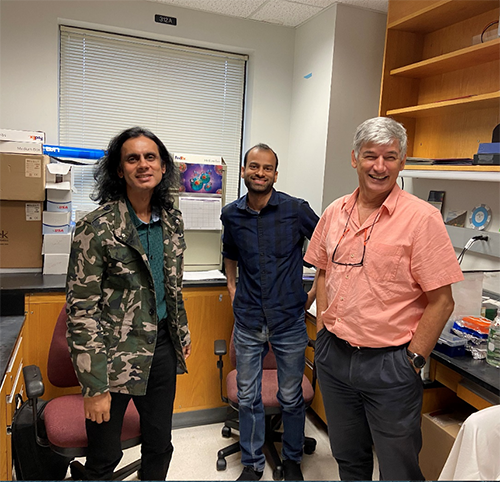 Naidoo, Nadeem, and Steyn in labI think of Dr. Steyn as an orchestra conductor or sports coach because of how he runs his research team. He brings in people with different talents and skill sets. He knows that the collaboration of individuals with diverse skills and knowledge is necessary to generate answers to research questions and expand the opportunities for people around the world to gain access to the materials and technologies we have. I can easily see the team approach between UAB and AHRI becoming a model for other universities and research centers to look to and say, “Look, they did it. We can do it too.”
Naidoo, Nadeem, and Steyn in labI think of Dr. Steyn as an orchestra conductor or sports coach because of how he runs his research team. He brings in people with different talents and skill sets. He knows that the collaboration of individuals with diverse skills and knowledge is necessary to generate answers to research questions and expand the opportunities for people around the world to gain access to the materials and technologies we have. I can easily see the team approach between UAB and AHRI becoming a model for other universities and research centers to look to and say, “Look, they did it. We can do it too.”
Q: What impact has this partnership had on your research?
Naidoo: In multinational alliances like this, developing countries are almost always concerned about only being seen as sample providers and then being relegated to the background. One of the many
positives of this alliance is that we have ensured that does not happen. This is important for me as well as for the other local collaborators from South Africa because we have the talent and capacity to make meaningful contributions to modern research. Our role in this collaboration is absolutely equal. Again, it’s something that we can proudly showcase to the rest of the world. If we can do it, it should not remain unique to us. In fact, we encourage others to copy it.
Benson: I was taught the term “parachute researchers” by Dr. Steyn. It refers to scientists and pathologists who jump to a country, do research, and then leave. We don’t want to be that. We are continually collaborating and looking for future goals to accomplish.
Naidoo: We would be hypocritical if we tried to do it all on our own. I must confess that once we put it out there that we are willing to collaborate and that we have human tissue available for collaborative research, we immediately received positive feedback and responses from numerous organizations, including groups from Harvard, the California Institute of Technology, the University of Pennsylvania, UAB, and King’s College in the U.K. These are some big hitters on the world scale. All it took was for us to say this is what we have, this is what we can do, and we are willing to collaborate.
We thought we would have to convince researchers to work with us, but that wasn’t the case. The opposite has been true. Researchers are eager to partner with us and genuinely appreciate our value and contributions. It has been affirming and satisfying in many ways. We hope to continue growing and strengthening this effort in the future.
If you are interested in the work being done by Dr. Benson and Dr. Naidoo in the UAB-AHRI partnership or collaborating on other global health opportunities, contact ghi@uab.edu.